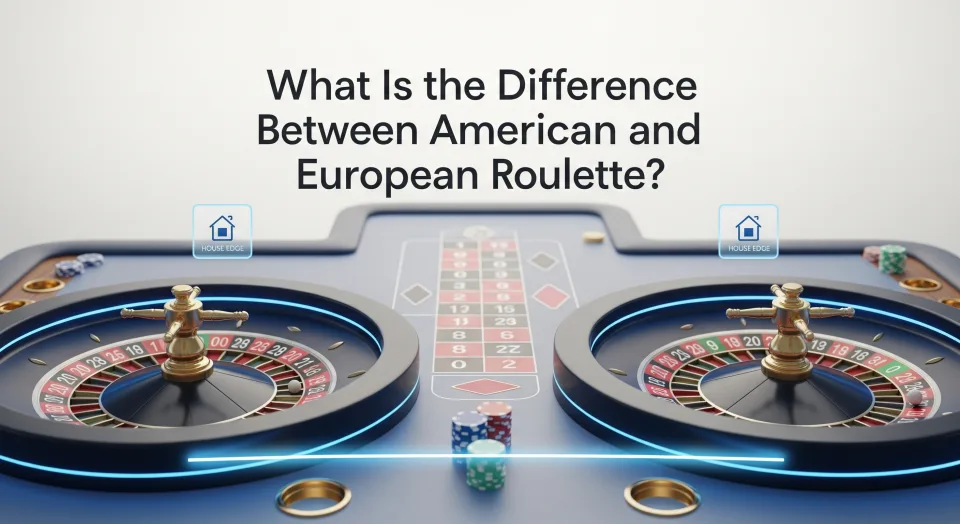What is the difference between American and European roulette? In one line: American roulette has two zeros (0 and 00) while European roulette has one zero (0). That extra pocket changes the house edge, odds, and long-term results. Below, we break down wheel layouts, betting options, payout math, and practical tips so you can pick the version that fits your goals and bankroll.
American vs European Roulette: The Core Difference
On an American roulette wheel you’ll see 38 pockets: numbers 1–36 plus 0 and 00. A European roulette wheel has 37 pockets: numbers 1–36 plus 0 only. That extra 00 increases the chance that the ball lands on a house number when you bet even-money outcomes, which raises the house edge. If you’ve wondered about the difference between the two versions, this is the detail that matters most.
-
European roulette house edge (single zero): ~2.70%
-
American roulette house edge (double zero): ~5.26% (about double)
Some European tables add La Partage (or En Prison) on even-money bets. If the ball hits 0, half your stake is returned (or held), cutting the effective edge on those bets to about 1.35%—a major point in the American vs European roulette comparison.
Why the House Edge Changes Your Results
The house edge is the casino’s average advantage over many spins. A higher edge doesn’t mean you’ll lose every time—it means that, over enough spins, more of your bankroll tends to drift to the house. Practically, players comparing American vs European roulette should expect longer, steadier sessions on the single-zero game, especially with La Partage active.
Wheel Layout & Track Design (Small Detail, Real Impact)
Beyond the extra 00, the number order around the rim differs. This affects section bets and neighbors on European wheels. For beginners, that nuance matters less than the core difference between American and European roulette (the extra 00), but if you play live dealer tables with call bets, layout knowledge becomes useful.
Payouts: Same Table, Different Value
Standard roulette payouts (e.g., 35:1 on a straight-up number) look identical on both wheels. The value differs because American roulette includes 00 while keeping payouts the same. That’s why the house edge rises on the double-zero wheel—same reward, slightly worse odds. This illustrates the difference between American and European roulette in practical terms.
Example (straight-up number):
-
European: 1 winning pocket out of 37 → probability ~2.70%
-
American: 1 out of 38 → probability ~2.63%
Even-Money Bets: Small Rule, Big Effect
If you like red/black, odd/even, or high/low, prefer European tables—ideally with La Partage:
-
European (no partage): 2.70% house edge
-
European + La Partage (even-money): ~1.35% effective edge
-
American (with 00): 5.26% house edge
For players weighing American vs European roulette, this single rule can halve the edge on your go-to bets.
Bankroll Planning (Simple, Smart Habits)
Regardless of version, plan your session like a pro:
-
Set a fixed session budget before you play (tips for managing an online gambling bankroll).
-
Use table minimums wisely: Spread small, even-money bets over more spins while learning the differences between the wheels.
-
Avoid tilt: If you’re tempted to chase losses, set deposit limits for responsible gambling and take a break.
-
Know the terms: If you use a bonus, read online casino terms and conditions and wagering requirements for casino bonuses; table games often contribute less to rollover.
Live Dealer Roulette: Does It Change Anything?
Are live dealer casino games rigged? Reputable studios are not; they stream a real wheel with standard physics. The math doesn’t change: a European live table still has 37 pockets; an American live table has 38. The difference between the two versions stays identical—choose by house edge and rules, then enjoy the croupier-run pace.
Common Myths (and What Actually Helps)
-
“Hot/cold numbers guarantee wins.” Outcomes are independent; previous spins don’t change the next.
-
“Betting systems beat the edge.” Progressions alter risk, not expected value.
-
“American pays more when you hit.” Payouts are the same; the extra 00 simply reduces hit probability.
What helps in the American vs European roulette decision: pick European (ideally La Partage), size bets sensibly, and take breaks.
Quick Side-by-Side: American vs European Roulette
| Feature | American Roulette | European Roulette |
|---|---|---|
| Zeros on the wheel | 0 and 00 (two zeros) | 0 only (single zero) |
| Pockets total | 38 | 37 |
| Typical house edge | ~5.26% | ~2.70% |
| With La Partage (even-money) | Rare | ~1.35% effective |
| Best for | Casual play if that’s what’s offered | Value-minded players; longer sessions |
Strategy Tips You Can Actually Use
-
If both versions exist, choose European. It’s the easiest way to reduce edge—central to the American vs European roulette choice.
-
Favor even-money bets (red/black, odd/even, high/low), especially with La Partage.
-
Avoid the “five-number bet” on American wheels (0-00-1-2-3)—its edge is even higher than 5.26%.
-
Set session limits and stick to them. If stress creeps in, review how to identify problem gambling habits and consider a timeout.
FAQs — What Is the Difference Between American and European Roulette?
Which pays better over time?
European roulette. Fewer house pockets (no 00) and La Partage on some tables lower the edge.
Can I find European wheels in the US?
Yes—many online casinos offer European alongside American. Look for single-zero in the title.
Is live dealer European roulette different from RNG European roulette?
Not in odds. Live dealer changes presentation, not math—the difference between the two versions remains the same.
If I must play American, any tips?
Keep bets modest, avoid the 0-00-1-2-3 wager, and manage time/bankroll carefully.
Final Verdict: American vs European Roulette
What is the difference between American and European roulette? The extra 00 on American wheels nearly doubles the house edge versus European. If you have a choice, pick European, and if available, La Partage for even-money bets. Combine that lower edge with solid bankroll habits, and you’ll get more play for your money—and a calmer roulette experience overall.

